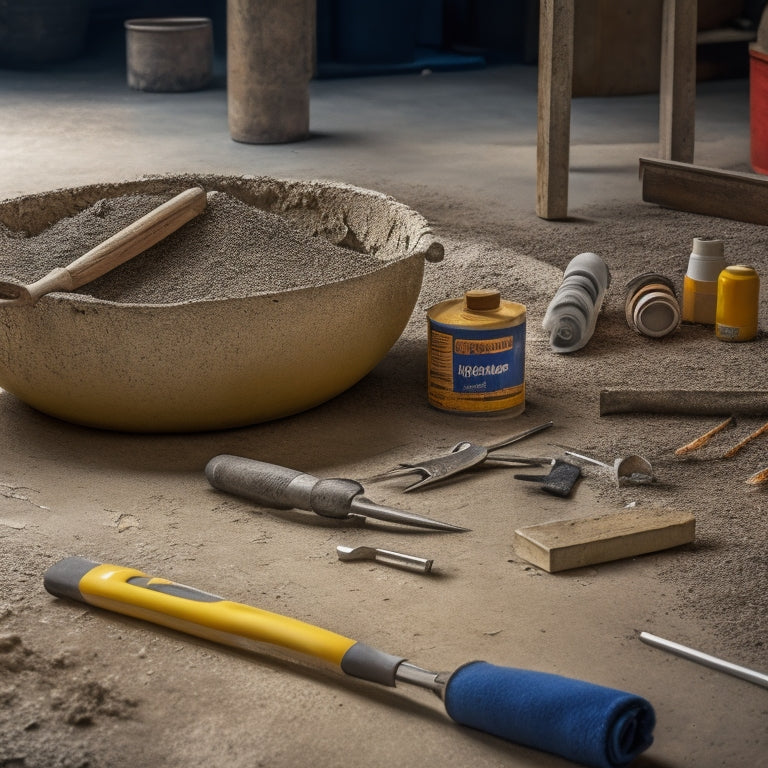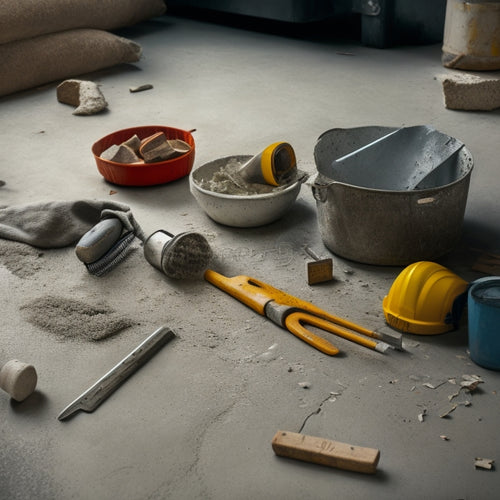
Top Tools for Repairing Cracked Concrete Surfaces
Share
When tackling a cracked concrete surface repair, you'll need the right tools to guarantee a durable fix. Start with epoxy injection guns for delivering controlled flows of epoxy resin into cracks and delaminations. Next, use concrete crack chaser saws to remove damaged concrete, followed by polyurethane foam injectors for precise foam delivery. Don't forget floor scraping tools for debris removal, cement grout pumps for injecting grout into narrow cracks, and surface preparation tools like wire brushes, scarifiers, and vacuum cleaners to ensure a strong bond. With these essential tools, you'll be well-equipped to tackle even the most challenging repairs - and understanding their nuances will make all the difference in achieving a successful outcome.
Key Takeaways
• Epoxy injection guns deliver controlled flow of epoxy resin into cracks and delaminations, ensuring effective repair techniques.
• Concrete crack chaser saws and surface preparation tools, such as grinders and scarifiers, prepare surfaces for strong bonding and minimize future cracks.
• Polyurethane foam injectors and cement grout pumps accurately fill cracks and voids, allowing for consistent and efficient repairs.
• Specialized scraping tools, including floor scrapers and angled edge scrapers, efficiently remove debris and old adhesives from concrete surfaces.
• Regular maintenance and inspection of tools, as well as following manufacturer guidelines, are crucial for optimal performance and successful repairs.
Epoxy Injection Guns
When repairing hairline cracks or delaminations in concrete structures, you'll likely reach for an epoxy injection gun, a precision tool designed to deliver a controlled flow of epoxy resin into the damaged area. This tool is vital for effective epoxy application techniques, allowing you to target the affected zone with precision.
To achieve ideal results, it's important to select the appropriate epoxy curing methods for your specific project. This may involve using a low-viscosity resin for narrow cracks or a high-viscosity resin for wider delaminations. You'll also need to take into account the ambient temperature and humidity, as these factors can greatly impact the curing process.
By mastering the use of an epoxy injection gun and understanding the nuances of epoxy application techniques and curing methods, you'll be able to restore structural integrity to damaged concrete surfaces with confidence.
With practice and patience, you'll develop the skills needed to tackle even the most complex repairs with ease.
Concrete Crack Chaser Saws
You'll typically reach for a concrete crack chaser saw to aggressively remove damaged or deteriorated concrete along the length of a crack, creating a clean, fresh surface for subsequent repair materials.
This powerful tool is fundamental for preparing cracks for repair, and mastering crack chaser techniques is essential for successful concrete restoration.
When using a crack chaser saw, it's important to maintain a consistent, steady pace to prevent uneven cutting and guarantee a smooth finish.
Additionally, regular chaser saw maintenance is important to extend the tool's lifespan and prevent premature wear. This includes regularly cleaning the saw blade, lubricating moving parts, and storing the saw in a dry, protected area.
By following these best practices, you'll be able to achieve professional-quality results and guarantee a strong, long-lasting repair.
Remember to always follow the manufacturer's guidelines and take necessary safety precautions when operating a crack chaser saw.
With the right techniques and maintenance, this tool will become an indispensable asset in your concrete repair arsenal.
Polyurethane Foam Injectors
With the crack fully prepared, you can now move on to filling it with a polyurethane foam injector, which accurately dispenses a precise amount of expanding foam into the repair area. This tool is essential for polyurethane applications, as it guarantees a consistent and controlled foam expansion.
Here are three key benefits of using a polyurethane foam injector:
-
Precise control: The injector allows you to regulate the amount of foam dispensed, guaranteeing a precise fill without over- or under-filling the crack.
-
Consistent expansion: The foam expansion is controlled, resulting in a consistent and even fill that matches the surrounding concrete.
-
Reduced waste: The injector minimizes foam waste, reducing the amount of material needed for the repair and saving you time and resources.
When selecting a polyurethane foam injector, look for one that's specifically designed for concrete repair and offers adjustable flow rates to accommodate varying crack sizes.
With the right injector, you can achieve professional-grade results and guarantee a long-lasting repair.
Floor Scraping Tools
When you're repairing concrete, you'll often encounter debris and old adhesive that needs to be removed.
To tackle this, you'll need floor scraping tools that can scrape and remove debris effectively, and concrete floor scrapers are a great option.
With angled edge scrapers, you can get into tight spaces and remove old adhesive, making way for a smooth repair.
Scrape and Remove Debris
Remove loose debris and old adhesives from the concrete surface using floor scraping tools, which are specifically designed to effectively scrape and collect material without damaging the underlying concrete.
These tools are essential for surface cleaning and debris collection, ensuring a smooth repair process.
Here are three key benefits of using floor scraping tools:
-
Efficient debris collection: Floor scraping tools allow you to quickly and easily remove loose material, saving you time and effort.
-
Precise surface cleaning: By scraping away old adhesives and debris, you can achieve a clean, even surface that's ready for repair.
-
Protection of underlying concrete: The specialized design of floor scraping tools prevents damage to the underlying concrete, ensuring a strong and lasting repair.
Concrete Floor Scrapers
You'll need a reliable concrete floor scraper to effectively scrape and remove debris from the surface, and there are several types of scrapers to choose from, each designed for specific tasks and surface conditions. When it comes to concrete maintenance tips, selecting the right scraper is essential for efficient floor repair techniques.
Here's a breakdown of some common concrete floor scrapers:
| Scraper Type | Recommended Use |
|---|---|
| Rigid Floor Scrapers | Ideal for scraping thick, hardened debris from rough surfaces |
| Flexible Floor Scrapers | Suitable for scraping delicate or uneven surfaces, such as those with aggregate exposure |
| Adjustable Floor Scrapers | Versatile option for scraping surfaces with varying levels of debris and roughness |
When choosing a scraper, consider the surface condition, debris type, and level of roughness. By selecting the right scraper, you'll be able to efficiently remove debris, prepare the surface for repair, and guarantee a successful concrete floor repair.
Angled Edge Scrapers
Precision is key when utilizing angled edge scrapers, which are specifically designed to tackle tight spaces, corners, and edges, where debris tends to accumulate.
You'll find these tools particularly useful in angled edge applications, such as removing old adhesive, paint, or epoxy from concrete surfaces. With their unique design, angled edge scrapers allow you to access areas that traditional scrapers can't reach.
Here are three vital tips to keep in mind when working with angled edge scrapers:
-
Choose the right scraper: Select an angled edge scraper that suits the specific task at hand. Consider the type of debris you're removing, the surface texture, and the angle of the edge.
-
Maintain your scraper: Regular scraper maintenance is essential to guarantee peak performance. Clean and inspect your scraper regularly to prevent clogging and damage.
-
Use the right technique: Apply gentle to moderate pressure, depending on the task, and work in small sections to maintain control and avoid damaging the surface.
Cement Grout Pumps
When injecting cement grout into narrow cracks or voids, a cement grout pump becomes an essential tool for efficiently delivering the necessary pressure and flow rate to fill the area effectively.
You'll find that these pumps are designed to handle the high pressures required to push grout through small openings, ensuring a successful repair.
To get the most out of your cement grout pump, it's vital to master cement application techniques, such as using the right grout mixing ratios. A general rule of thumb is to mix one part cement to one part sand, but this can vary depending on the specific requirements of your project.
By following the manufacturer's guidelines and adjusting your technique accordingly, you can achieve a smooth, consistent flow that fills the crack or void completely.
With a cement grout pump in your toolkit, you'll be able to tackle even the most challenging concrete repairs with confidence.
Surface Preparation Tools
Properly preparing the surface of the concrete is essential to guaranteeing a strong bond between the old and new material, and that's where surface preparation tools come in. These tools allow you to clean, abrade, and profile the area to perfection.
To get started, you'll need the right tools for the job. Here are three must-haves for surface preparation:
-
Wire brushes: For aggressive surface cleaning and removing loose debris, wire brushes are the way to go. They're especially effective at removing dirt and grime that can interfere with the repair process.
-
Scarifiers: These tools are designed for heavy-duty surface profiling, allowing you to remove old coatings, roughen the surface, and create a strong bond between the old and new material.
-
Vacuum cleaners: A reliable vacuum is essential for removing dust and debris generated during the surface preparation process. This guarantees a clean surface for crack assessment and repair.
Frequently Asked Questions
How Do I Determine the Best Tool for My Specific Concrete Repair Job?
When determining the best tool for your specific concrete repair job, you'll want to employ savvy tool selection strategies.
Start by evaluating your project using techniques that consider factors like crack width, depth, and location.
Evaluate the repair material and desired finish to narrow down your options.
Then, research tools that cater to your specific needs, weighing pros and cons before making an informed decision.
What Safety Precautions Should I Take When Working With Concrete Repair Tools?
When working with concrete repair tools, you must prioritize safety.
You're responsible for taking necessary precautions to avoid injuries and exposure to hazardous materials.
Wear personal protective equipment, such as gloves, safety glasses, and a dust mask, to shield yourself from debris and dust.
Practice proper tool handling techniques, ensuring a firm grip and controlled movements to prevent accidents.
Always follow the manufacturer's guidelines and instructions for each tool to minimize risks.
Can I Use These Tools for Repairing Cracks in Walls as Well as Floors?
When tackling crack repairs, you're probably wondering if your tools are versatile enough for both wall repair and floor repair.
The answer is yes! Most concrete repair tools are designed for universal use, making them suitable for both vertical and horizontal applications.
However, you'll need to adjust your technique and material selection based on the specific requirements of each surface.
For instance, wall repairs often require more precision and control, while floor repairs demand more strength and durability.
How Do I Properly Clean and Maintain My Concrete Repair Tools?
You've invested in high-quality concrete repair tools, now it's essential to keep them in prime condition.
Take the case of John, who neglected his tools and ended up with rusted trowels and clogged mixing buckets. Don't follow in his footsteps!
Properly clean your tools after each use, and store them in a dry, organized space - a designated tool storage area is a must.
Follow these maintenance tips: regularly inspect and sharpen blades, and lubricate moving parts to guarantee efficiency and extend their lifespan.
Are There Any Specific Training or Certifications Required for Concrete Repair?
You're taking the right step by asking about certifications for concrete repair.
While not mandatory, obtaining certifications can elevate your skills and credibility.
Look for certification programs, such as the American Concrete Institute's (ACI) Concrete Repair Specialist certification, which requires passing an exam and meeting experience requirements.
You can also enroll in training courses, like the ACI's Concrete Repair and Restoration courses, to gain hands-on experience and enhance your knowledge of repair techniques and materials.
Conclusion
With these top tools in your arsenal, you're ready to tackle even the most intimidating cracked concrete surfaces.
Like a master surgeon, you'll precision-cut, inject, and fill cracks with ease, leaving surfaces smooth and strong.
From epoxy injection guns to surface preparation tools, each one is an essential instrument in your repair orchestra, working in harmony to create a symphony of strength and durability.
With these tools, you'll be the conductor of concrete repair, directing a flawless performance every time.
Related Posts
-

Must-Have Tools for Laying Concrete Tiles
When laying concrete tiles, you'll need a range of essential tools to get the job done right. Start with subfloor pre...
-

Top 10 Concrete Repair Tools for Small Fixes
You'll need the right tools to tackle small concrete repairs efficiently and effectively. When it comes to small fixe...
-

Essential Tools for Epoxy Concrete Floor Repair
You'll need a thorough arsenal of specialized tools to guarantee a successful epoxy concrete floor repair. Floor prep...


